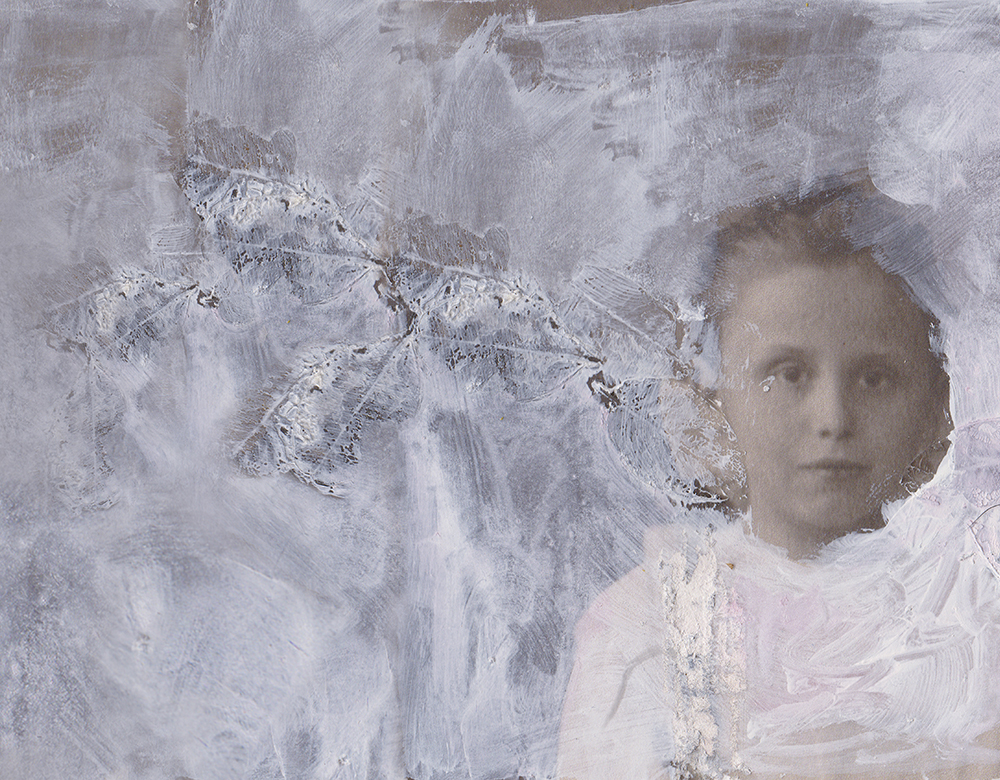A visual artist specializing in creative photography, portraiture, and broadly understood photographic experimentation.
Her extensive project, consisting of several series, titled „Threads of Forgetfulness” was showcased at the Centre of Contemporary Art in Toruń in 2021. Since then, she has continued to explore the realms of memory, using archival visual material: not only from her own family, but also from completely anonymous individuals.
She eagerly incorporates photos, and even entire albums, which are no longer needed and sold at flea markets, into her series. Through symbolic adoption, she attempts to restore their memory and dignity. In her works, she uses not only photography but also collage and photomontage. She is also keen on employing historical photographic techniques.
She uses wax, Japanese paper, and other materials to create objects — assemblages. The theme of family is still present in her work, resonating clearly in the series „Pink Doesn’t Exist”.
She studies at The Institute of Creative Photography in Opava and she is a member of The Union of Polish Art Photographers in the Silesian District. She is also the author of two art books: „Herbarium” (2021) and „Pink Doesn’t Exist” (2023). Her works are included in the collections of the Silesian Museum in Katowice as well as in private collections.
Website | Instagram
Artist Statement
Unsettling beauty of oblivion
Fragile and ethereal. They are constantly on the run, never allowing themselves to be fully tamed. They happen to suddenly flare up with a bright, strong glow and stay with us for a long time. Then they illuminate our present and have great power: they can surprise, amuse or delight us. However other times you have to wait in the darkness of oblivion for a long time for them to appear. They reveal themselves in irregular cycles, the rhythm of which they establish independently from us. This is how – insensitive to human needs and longings – our own memories play with us. Their character, seemingly virtually elusive, was rendered in a visually sophisticated way by Iwona Germanek.
There has already been written a lot of the specific working mechanics of human memory, its selectivity, not only from sociological, but also philosophical and cultural studies perspectives. For example, the eminent French historian Pierre Nora asked about the location of ‘sites of memory’, inspiring successive generations of scholars to address the issue.
Others attempted to classify the various types of ‘depositories of memory’ and put them into a methodologically clear framework. Iwona Germanek’s project significantly complements the optics of the existing discourse on memory. The power of Herbarium is revealed at the point where theory proved ineffective: for the artist was able to give form and colour to memories, to embody the formless.
In an age of overproduction of images and at the same time the hermetic nature of many contemporary works of art, Germanek adopts her own original strategy: she pursues a project that is unique not only in terms of the disturbingly captivating aesthetics of the works, but also in terms of the universal content, which we decode intuitively.
In an aesthetically sublime manner, the artist reaches for purple and pink and then juxtaposes them with a whole array of browns. The photographs of various people from the past (judging by their clothes from a bygone era) are marked by a masterful combination of cool brown, umber, golden ochre and a hint of slightly reddish burnt sienna. The centuries-old tradition associated with various shades of brown, meanwhile, connotes natural raw materials such as wood, earth, sand or various types of minerals and rocks.
Thus Germanek clearly brings out the symbolic relationship of this colour to the natural cycle of life, of which decomposition and atrophy are key elements. In her project the artist also makes use of tangible fragments of dried flower petals and plant fragments, poignant in their reality – half-dead, half-rescued from total destruction. The floral motifs appearing in Germanek’s works are, in turn, strongly rooted in the painterly culture of creating still lifes, the subject matter of which oscillated around the transience of all matter. The artist enters into a conscious dialogue with history, showing that contemporary visual strategies can creatively refer back to the origins of the photographic medium. At that time, after all, it was not only William Henry Fox Talbot or Anna Atkins, but also figures such as Charles Hippolyte Aubry, Johann Carl Enslen, Calvert Richard Jones or Sebastiano Tassinari who used plants as an essential element in their work. However their aim was quite different from Germanek’s: the intention of the early photographers was to document various species with a view to botany or to create aesthetically appealing compositions. Whereas Germanek, rather than recording and commemorating, works with the power of understatement. In her work photography is by no means conceived as an instrument for the accumulation of memories, but as a method for capturing their fascinating and poignant labile nature.
Knowledge of ourselves, as Germanek shows, turns out to be full of fuzziness and gaps.
Herbarium is an invitation to reflect on our identity, which is in a constant, dynamic state of flux, inherent in the intergenerational exchange of memories. This transfer, however, is marked by afterimages of human presence rather than encyclopaedically accurate histories. In a perverse way Germanek’s Herbarium negates the thesis of the possibility of creating a traditional, ordered atlas of knowledge about ourselves. The artist creates the space of a performative archive in which contemporary and ancient images, traces and cracks, knowledge and uncertainty collide. Presence is combined with absence and the whole is bathed in a poignantly beautiful, yet melancholic, palette of violets and browns.


0 comments on “Iwona Germanek”